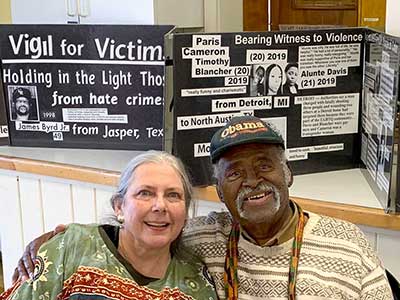by Carol Anderson | June 2021
For too long, the second amendment has been portrayed with a founding fathers aura swaddled in the stars and stripes. But “a well-regulated militia” wasn’t, as the story goes, about how valiant and effective the militias were in repelling the British. George Washington was disgusted with their lack of fighting ability and the way the men would just cut and run from battling against a professional army. Nor was the militia reliable as a force to uphold the law. In Shays’ Rebellion, bands of armed white men, who were in the state’s militia, attacked the Massachusetts government because of foreclosures and debt seizures, demonstrating, again, how unreliable the militia were. Boston merchants had to hire mercenaries to put down the rebellion.
On the other hand, where the militia had been steadfast was in controlling the enslaved Black population. Access to guns for white people was essential for this function.
TAGS: [Racial Terrorism] [2020’s] [Economics] [Justice System] [White Supremacy] [White Culture] [White Privilege] [Politics] [White Blindness] [White Defensiveness] [History] [Black Lives Matter] [Social Justice] [Systemic Racism] [Slavery] [Policing] [Silencing POC]
by Julie Zauzmer Weil, Adrian Blanco and Leo Dominguez| January 2022
From the founding of the United States until long after the Civil War, hundreds of the elected leaders writing the nation’s laws were current or former slaveowners. More than 1,700 people who served in the U.S. Congress in the 18th, 19th and even 20th centuries owned human beings at some point in their lives, according to a Washington Post investigation of censuses and other historical records.
TAGS: [Racial Terrorism] [2020’s] [Civil War] [Slavery] [Politics] [Systemic Racism] [White Supremacy] [White Culture] [White Privilege] [White Blindness] [Justice System] [History] [Black Lives Matter] [Silencing POC] [Confederate Monuments] [Indigenous]
by Shane Shifflett, Alissa Scheller, Scilla Alecci and Nicky Forster | December 2015
Long before Chicago police Officer Jason Van Dyke shot and killed a black teenager, sparking a public outcry and now a Justice Department probe into the city’s troubled police department, he had established a track record as one of Chicago’s most complained-about cops. Since 2001, civilians have lodged 20 complaints against Van Dyke. None were sustained by investigators. While it may seem surprising that so many complaints against one officer would be tossed out, a Huffington Post analysis of four years of city data released by the Invisible Institute, a nonprofit journalism organization, reveals that there are more than 180 city police officers with more complaints than Van Dyke who weren’t disciplined at all over that time. Most of those complaints were made by black residents, whose allegations of police misconduct are dismissed at nearly four times the rate of complaints filed by whites, HuffPost found.
TAGS: [Racial Terrorism] [2010’s] [Police Shootings] [Policing] [Black Lives Matter] [Justice System] [Silencing POC] [Denial] [Accountability] [Systemic Racism] [-ing While Black]
by history.com Editors| Updated January 2022
Jim Crow laws were a collection of state and local statutes that legalized racial segregation. Named after a Black minstrel show character, the laws—which existed for about 100 years, from the post-Civil War era until 1968—were meant to marginalize African Americans by denying them the right to vote, hold jobs, get an education or other opportunities. Those who attempted to defy Jim Crow laws often faced arrest, fines, jail sentences, violence and death.
TAGS: [Racial Terrorism] [2020’s] [Systemic Racism] [Silencing POC] [Racial Covenants] [History] [Collective Action] [Denial] [Politics] [White Supremacy] [White Culture] [White Privilege] [Black Lives Matter] [Policing] [Prison System] [Housing] [Justice System] [Advocacy] [Role Model] [Definitions]
by David Sharp | December 2021
Most Americans know about atrocities endured by Native Americans after the arrival of European settlers: wars, disease, stolen land. But they aren’t always taught the extent of the indiscriminate killings. Members of the Penobscot Nation in Maine have produced an educational film addressing how European settlers scalped — killed — Indigenous people during the British colonial era, spurred for decades by cash bounties and with the government’s blessing. “It was genocide,” said Dawn Neptune Adams, one of the three Penobscot Nation members featured in the film, called “Bounty.” She said the point of the effort isn’t to make any Americans feel defensive or blamed. The filmmakers say they simply want to ensure this history isn’t whitewashed by promoting a fuller understanding of the nation’s past. At the heart of the project is a chilling declaration by Spencer Phips, lieutenant governor of the Province of Massachusetts Bay.
TAGS: [Racial Terrorism] [2020’s] [Indigenous] [Systemic Racism] [History] [Social Justice] [White Supremacy] [White Privilege] [White Culture] [Politics] [Economics] [Teachers] [White Blindness]
by Fakiha Baig | June 2021
A Cree woman had just given birth to her sixth child in Saskatoon, when she was presented with a consent form for her sterilization. “She tried to wheel herself away from the operating room, but the doctor wheeled her right back in the direction of the same operating room,” says a new government report, which details the woman’s sterilization in 2001. “When she was in the operating room, she kept asking the doctor if she was done yet. Finally, he said, ‘Yes. Cut, tied and burnt. There, nothing is getting through that.”’
TAGS: [Racial Terrorism] [2020’s] [Indigenous] [Systemic Racism] [White Supremacy] [History] [Health Disparities]

















